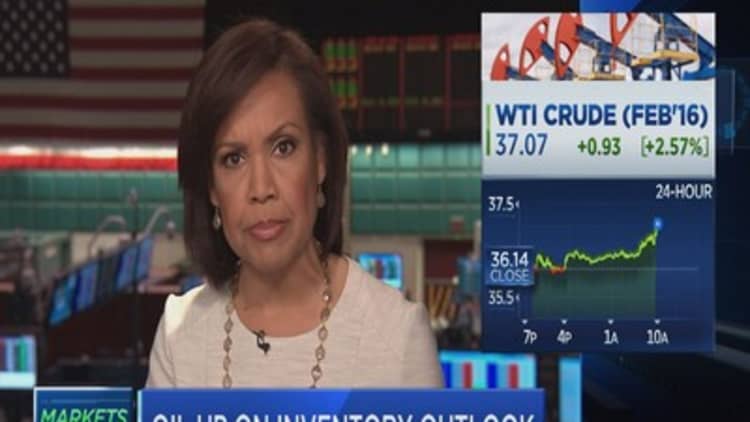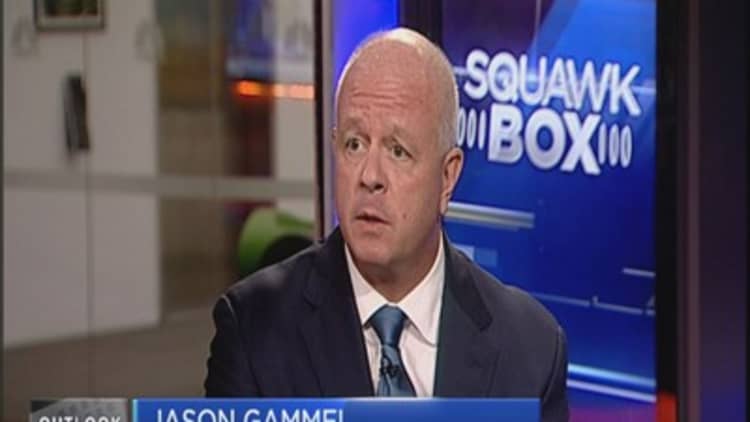


U.S. oil futures rose as much as 4 percent on Wednesday, underpinned by an unexpectedly large fall in U.S. crude inventories, but were still close to multi-year lows as supplies remained abundant and as OPEC lowered the demand outlook for its exports.
The data surprise prompted crude futures for both U.S. West Texas Intermediate and global Brent to rise to a session high.
WTI futures settled $1.36 higher, or 3.76 percent, at $37.50, having risen as high as $37.79. Brent futures were up $1.32, or 3.63 percent, at $37.42 a barrel, off a session peak of $37.44.
The Energy Information Administration reported crude inventories fell by 5.9 million barrels in the last week, compared with analysts' expectations for an increase of 1.1 million barrels. Crude stocks at the Cushing, Oklahoma, delivery hub rose by 2 million barrels, EIA said.
Baker Hughes also released data showing U.S. oil rigs falling by three. Oil rigs in the U.S. now total 538, but are still down 961 from a year ago.
Earlier data published by industry group the American Petroleum Institute had suggested U.S. crude inventories fell by 3.6 million barrels last week to 486.7 million.
Meanwhile, gasoline stocks rose by 1.1 million barrels, compared with analysts' expectations in a Reuters poll for a 1.4 million barrels gain. Distillate stockpiles, which include diesel and heating oil, fell by 661,000 barrels, versus expectations for a 2.0 million barrels increase, the EIA data showed.
U.S. crude futures traded above benchmark Brent prices on Wednesday, a pattern rarely seen over the last five years. Brent settled below U.S. crude for the first time since August 2010 on Tuesday and touched $35.98 on an intraday basis, its lowest since July 2004.
The Organization of the Petroleum Exporting Countries (OPEC) in a report on Wednesday forecast that demand for its crude would be lower in 2020 than in 2016 as rival producers prove more resilient than expected in a low oil price environment.
It forecast 2020 demand for OPEC crude at 30.7 million barrels per day (bpd) versus 30.9 million bpd in 2016 and about 1 million bpd less than it is currently producing.
OPEC raised its forecast for tight oil output to 5.19 million bpd in 2020, up from 4.5 million bpd in its 2014 report.
OPEC failed to agree on a production ceiling at a Dec. 4 meeting in Vienna for the first time in decades. Saudi King Salman said on Wednesday the kingdom was concerned about the stability of the oil market, but added that Saudi Arabia remained committed to further exploration activities in the oil and gas sectors.
In a sign of growing competition for market share among OPEC members in Asia, Iraq signed a $1.4 billion deal to supply 160,000 bpd to Indian refiners Reliance and Indian Oil Corp.
Iran is expected to add 500,000 bpd of crude exports next year and Iranian officials have already met with Indian refiners seeking proposals on how to make their crude more competitive.
On Wednesday, Brent traded as low as $36.28 a barrel, flipping WTI from a long-standing discount into a slight premium over the international benchmark for the first time since a short period in November 2014.
Since 2010, U.S. petroleum imports have fallen from a peak of almost 14 million barrels per day (bpd) to around 9 million bpd, government data shows.
But as shale output dips and the government eases restrictions on crude exports, the U.S. market could tighten while global supplies swell on sustained high output from Russia and OPEC.
Although no immediate large-scale exports are expected, some U.S. oil will likely flow from the United States into the global market next year.
—CNBC's Tom DiChristopher contributed to this story.




